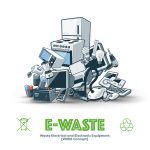Adding value to remanufacturing through Reverse Logistics
By Dr Stavros Kamperidis, Heriot Watt University
In Scotland, around 135,540 tonnes of WEEE is generated each year. In terms of unit numbers, small WEEE like household appliances, mobile phones and computers represent a larger volume of goods but a lower reuse/recycling rate than the larger WEEE items such as white goods and televisions. Small WEEE also contain a high proportion of hazardous materials so diverting these away from landfill is environmentally beneficial, and there are also economic benefits associated with recovering and reusing expensive components.
 WEEE is typically collected through centralised collection sites (e.g. Households Waste Recycling Centres, HWRC) where end-users can take their unwanted WEEE items for disposal. However, due to poor handling, transportation and storage damage, items collected this way tend to be unsuitable for reuse due to their poor condition so are diverted to the lower value recycling pathway or landfill. Whilst reuse schemes for large WEEE items are well established, the reuse of small WEEE items is still relatively underdeveloped.
WEEE is typically collected through centralised collection sites (e.g. Households Waste Recycling Centres, HWRC) where end-users can take their unwanted WEEE items for disposal. However, due to poor handling, transportation and storage damage, items collected this way tend to be unsuitable for reuse due to their poor condition so are diverted to the lower value recycling pathway or landfill. Whilst reuse schemes for large WEEE items are well established, the reuse of small WEEE items is still relatively underdeveloped.
Stavros Kamperidis and his team at Heriot Watt University are undertaking a pilot study to utilise Menzies Distribution’s extensive logistics network in the return of small household Waste Electrical and Electronic Equipment (WEEE) to supply local remanufacturing companies for reuse activities.
This project sought to identify opportunities in which the volumes and quality of small WEEE could be increased by developing a sustainable collection and transport solution.
Menzies Distribution operate a network of vehicles and warehouses that serves 25,000 retail customers across the UK and Ireland, delivering 7.4 million copies of newspapers and magazines every day. The company use 1,756 delivery vehicles which travel a combined 135,000 miles each day and make 109,000 deliveries per day. Whilst outbound journeys are well used, most of Menzies’ return journeys (backhauls) are underutilised which presents an improvement opportunity.
Findings/Outputs
The team developed a series of Casual Loop Diagrams (CLD) to understand the causes, impacts and critical factors associated with WEEE collection. These were used to facilitate the design of a reverse logistics network for the recovery of small WEEE items;
It was identified that the solution should
- minimise the investment cost in vehicles and crew
- minimise the weekly routeing cost whilst guaranteeing a collection service level.
Collection was identified as a critical stage for volume aggregation and where diversion of WEEE down the most appropriate treatment streams occurs (reuse or recycle).
It was determined that a successful collection system requires WEEE to be uplifted directly from a convenient location and from a staffed premises – such as a shop. Economic analsysis indicated that the proposed collection system was cost-effective and identified that the quality of returned products will directly impact on the profitability of the system.
Menzies’s network of retailers and convenience stores can function as decentralised drop-off points to collect small WEEE. The staffed drop-off site system allows shop staff to check and segregate the returned goods as they arrive. The deposited WEEE items are then simultaneously collected by Menzies when they carry out their standard newspaper delivery, stored and transported by Menzies’ to a product recovery centre for reuse/recycling processing. This collection system will provide a convenient way for end-users to dispose of their small WEEE, whilst allowing Menzies to better utilise their normally empty back haul journeys.
Conclusion and next steps
The next stage of the project is to test the proposed collection system through a live pilot project with Menzies and their network partners. The project will determine the feasibility of integrating the collection of small WEEE within Menzies’ existing distribution network, and to the impact of the system on the return and reusability rate of the collected WEEE.
Funding from the Scottish Institute for Remanufacture enabled the initial research and has funded the pilot study of the solution due to kick off in 2018.

